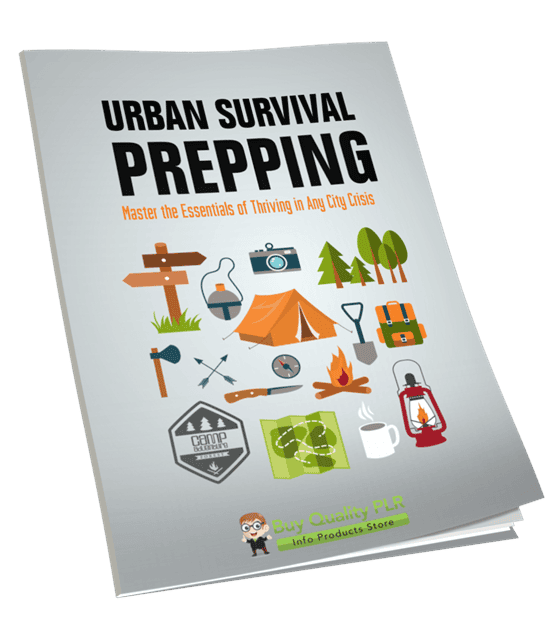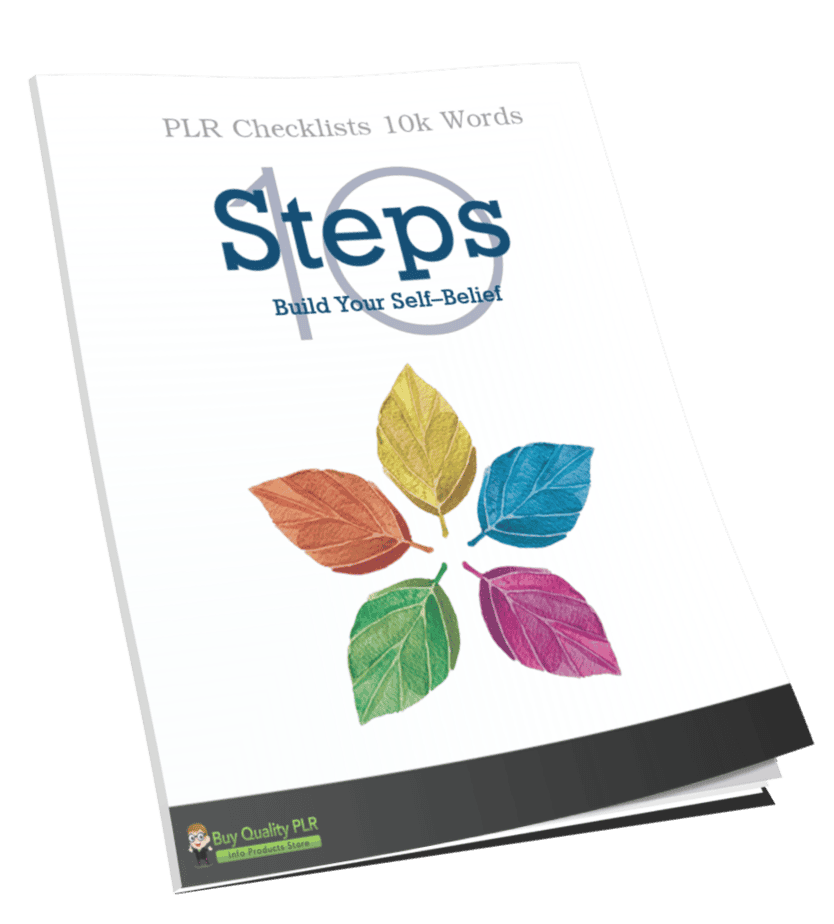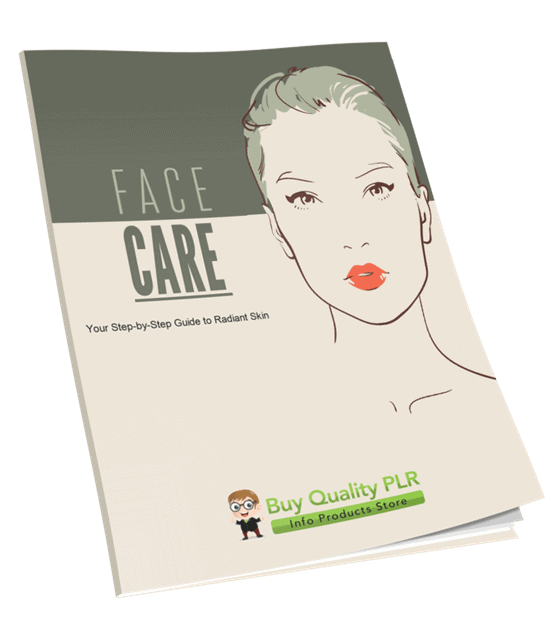
Face Care PLR Course 24k Words
in Beauty PLR , Health PLR , Health PLR eBooks , PLR eBooks , PLR eCourses , PLR List Building Reports , Premium PLR , Premium PLR eBooks , Premium PLR Reports , Premium White Label Brandable PLR Coaching Courses , Private Label Rights Products , Skin Care PLRChoose Your Desired Option(s)
has been added to your cart!
have been added to your cart!
#facecareplr #skincareplr #beautycareplr #plrskincare #facecareguide #beautytipsplr #skincareroutine #naturalskincareplr #selfcareplr #beautyplr
Face Care PLR Course: Your Step-by-Step Guide to Radiant Skin
Welcome to the Face Care PLR Course, your ultimate guide to achieving healthy, glowing skin through a simple and effective skincare routine. Whether you’re a beginner or looking to improve your current skincare regimen, this course provides a structured approach to understanding your skin and implementing the right techniques for radiant results.
This course offers practical tips, step-by-step guidance, and expert advice on skincare, including natural remedies, face care products, and advanced techniques to ensure you’re taking the best care of your face.
Presenting…
Face Care PLR Course 24k Words
Course Overview
Taking care of your skin doesn’t have to be complicated. With the right approach, you can achieve glowing, healthy skin without spending hours on skincare routines. The Face Care PLR Course is designed to be easy-to-follow and highly effective. Each module provides clear instructions and actionable steps to help you build a solid skincare routine that fits your needs and lifestyle.
Whether you’re dealing with dryness, acne, aging, or sensitivity, this course offers something for everyone. Learn how to identify your skin type, select the right products, and use natural remedies to enhance your skincare game.
Course Modules:
Module 1: Understanding Your Skin
In this module, you’ll learn how to identify your skin type, recognize common skin concerns, and understand how to choose the right ingredients for your skin. Knowledge is power, and by understanding your skin’s needs, you can make better decisions about your skincare routine.
- Step 1: Identify Your Skin Type
Discover the four main skin types: oily, dry, combination, and normal. We’ll show you how to perform a simple test to determine your skin type and ensure you’re using the right products. - Step 2: Understand Common Skin Concerns
From acne to dark spots, learn how to address common skin concerns and understand what triggers them. - Step 3: The Importance of Knowing Ingredients
Understanding skincare ingredients is key to selecting the right products. We’ll guide you on how to read labels and pick ingredients like hyaluronic acid, salicylic acid, and more to match your skin’s needs. - Step 4: Building a Skincare Mindset
Skincare is not just about products; it’s about creating a mindset for self-care. Learn how to set realistic expectations and treat your skincare routine as a daily practice for your overall well-being.
Module 2: Building Your Skincare Routine
Now that you understand your skin, it’s time to build a solid skincare routine that works for you. This module teaches you how to create a simple but effective skincare regimen that covers cleansing, toning, moisturizing, and sun protection.
- Step 1: Start with Cleansing
Cleanse your skin to remove dirt, oil, and impurities. We’ll guide you in choosing the right cleanser for your skin type and explain why cleansing is essential. - Step 2: Tone It Up
Learn the role of toners in balancing your skin’s pH. Find out whether hydrating or clarifying toners are best for your skin. - Step 3: Moisturizing Like a Pro
Hydration is key for all skin types. Discover the importance of moisturizing and learn how to apply it properly for maximum absorption. - Step 4: Don’t Skip Sunscreen
Sunscreen is crucial for protecting your skin from harmful UV rays. Learn how to choose the right SPF and how to apply it effectively to protect your skin from damage and premature aging.
Module 3: Advanced Face Care Techniques
Take your skincare to the next level by incorporating advanced techniques such as exfoliation, face masks, and eye care. This module teaches you how to use these methods to enhance your skin’s health and appearance.
- Step 1: Exfoliation Essentials
Learn how exfoliating removes dead skin cells and promotes a brighter complexion. We’ll explore both physical and chemical exfoliants and help you choose the best option for your skin type. - Step 2: Face Masks and Treatments
Discover the different types of face masks (clay, sheet, gel) and their benefits. Learn how to use treatments like serums and spot correctors for targeted results. - Step 3: Incorporating Eye Care
The delicate skin around your eyes needs special care. Learn how to use eye creams and gels to reduce puffiness and dark circles. - Step 4: Nighttime Skincare Routine
Nighttime is when your skin repairs itself. Learn how to create a nighttime skincare routine that ensures maximum hydration and skin renewal while you sleep.
Module 4: Natural Face Care Remedies
Sometimes, the best skincare solutions come straight from nature. This module explores natural ingredients and remedies that can enhance your skincare routine without harsh chemicals.
- Step 1: Using Natural Ingredients
Learn how honey, aloe vera, turmeric, and other natural ingredients can nourish your skin. We’ll share simple DIY recipes for face masks and scrubs that you can make at home. - Step 2: Staying Hydrated from Within
Discover the importance of drinking water for healthy skin and the best foods to eat for radiant, glowing skin. We’ll show you how a skin-friendly diet can enhance your outer appearance. - Step 3: Stress Management for Better Skin
Stress can wreak havoc on your skin. Learn simple relaxation techniques like meditation and breathing exercises to reduce stress and improve your skin. - Step 4: Avoiding Skin-Damaging Habits
Identify harmful habits such as touching your face or not removing makeup. We’ll teach you how to break these habits and promote healthier skin.
Module 5: Troubleshooting and Staying Consistent
In this final module, we’ll address common skin issues and offer tips for maintaining a consistent skincare routine. Learn how to troubleshoot breakouts, adapt your routine to seasonal changes, and track your progress.
- Step 1: Dealing with Breakouts
Learn effective strategies for treating acne and irritation. We’ll cover spot treatment techniques and when it’s necessary to seek professional help. - Step 2: Adapting Your Routine to Seasons
Learn how seasonal changes affect your skin and how to adjust your skincare routine accordingly. - Step 3: Tracking Your Progress
Discover ways to monitor improvements in your skin and keep track of your journey. Celebrate small wins to stay motivated! - Step 4: Staying Consistent
Build daily habits that make skincare easy and enjoyable. Learn how to stay committed to your routine even on the busiest days.
Final Thoughts
Congratulations on completing the Face Care PLR Course! By now, you have a comprehensive understanding of skincare, from identifying your skin type to creating a personalized routine that suits your needs. Remember, great skin is a journey, not a sprint. Be patient, consistent, and kind to yourself, and let’s get glowing!
Bonus Materials Included
To further enhance your learning experience, we’ve included the following bonus materials:
- Face Care Checklist – 476 words
- Face Care FAQs – 1,053 words
- Face Care Sales Page – 541 words
These additional resources will help you implement your face care routine more effectively and provide you with ready-made content for marketing and sales purposes.
How You Can Use and Profit from This Course
The Face Care PLR Course comes with full Private Label Rights (PLR), which means you can modify and resell this content as your own. Here are some ways to use this course to generate income:
- Sell the Course as-is: Offer the course as an online program or ebook for individuals looking to improve their face care routine.
- Create a Membership Site: Use this course as part of a subscription-based service where users can access new skincare content every month.
- Bundle with Other Beauty Products: Combine this course with other beauty or wellness resources you offer to create a larger product package.
- Offer it as a Lead Magnet: Break up the content into smaller portions like blog posts or downloadable PDFs and use them to grow your email list.
- Convert into Physical Products: Transform the course into a workbook or guidebook and sell it in physical format.
- Create Audio or Video Content: Use the course content to create audio or video tutorials for a more interactive experience.
License Terms:
What You Can Do:
- Sell the content as-is with minor adjustments.
- Break the content into small portions and sell them individually.
- Bundle it with other products for larger offers.
- Set up a membership site and create recurring income.
- Convert it into a multi-week “eclass” for higher pricing.
- Create physical products like books or journals.
- Convert content into audio, video, or interactive materials.
What You Can’t Do:
- Pass on the PLR rights to your customers.
- Offer 100% affiliate commissions.
- Give away the complete materials for free.
Act Now – Download Your Course and Start Your Skincare Journey Today!
Start Your Skincare Journey Today with the Face Care PLR Course and unlock the secret to healthy, glowing skin that’s simple, sustainable, and effective. Don’t wait—get started now and enjoy radiant skin!
has been added to your cart!
have been added to your cart!
Here A Sample of Face Care PLR Course
Welcome to the ultimate guide to face care! This course is designed to help you understand and implement a simple yet effective routine to achieve healthy, glowing skin. Whether you’re a beginner or looking to improve your skincare game, these modules will guide you step-by-step. Let’s dive in!
Module 1: Understanding Your Skin
Before you start any face care routine, it’s important to know your skin type and its needs.
Step 1: Identify Your Skin Type
Understanding your skin type is the cornerstone of an effective skincare routine. This step will help you personalize your face care journey by choosing products and practices tailored to your unique skin needs. Here’s a detailed breakdown of how to identify your skin type and the steps to perform a simple at-home test.
1. Learn About the Four Main Skin Types
Each skin type has distinct characteristics. Familiarizing yourself with these will make it easier to determine where your skin fits.
a. Oily Skin:
- Characteristics:
- Skin appears shiny, particularly on the T-zone (forehead, nose, and chin).
- Enlarged pores are more visible.
- Prone to blackheads, whiteheads, and acne.
- Common Causes: Overactive sebaceous glands producing excess oil.
b. Dry Skin:
- Characteristics:
- Skin feels tight, especially after cleansing.
- May appear dull or flaky with rough patches.
- Less prone to acne but can develop redness or irritation.
- Common Causes: Lack of oil production, environmental factors, or aging.
c. Combination Skin:
- Characteristics:
- A mix of oily and dry areas.
- Typically, the T-zone is oily, while cheeks are dry or normal.
- May experience occasional breakouts in oily areas.
- Common Causes: Genetic factors or hormonal changes.
d. Normal Skin:
- Characteristics:
- Balanced oil production with no noticeable dryness or excess shine.
- Small, barely visible pores.
- Rarely experiences breakouts or sensitivity.
- Common Causes: Healthy hydration and sebum production.
2. Why Knowing Your Skin Type Matters
Your skin type determines which products will work best for you. For instance:
- Using heavy moisturizers on oily skin can clog pores and cause acne.
- Harsh exfoliants on dry skin can worsen irritation.
- Tailoring your skincare routine prevents trial-and-error frustration and saves time and money.
3. Perform a Simple Test at Home
This easy at-home test will help you identify your skin type with confidence. Set aside about an hour for this process.
Step 1: Cleanse Your Face
- Wash your face gently with a mild, non-stripping cleanser.
- Avoid using exfoliants, toners, or serums at this stage.
- Rinse thoroughly with lukewarm water and pat dry with a clean towel.
- This step removes dirt, oil, and makeup, allowing your natural skin behavior to surface.
Step 2: Wait for 1 Hour
- Let your skin rest without applying any products.
- Stay in a neutral environment (avoid extreme heat, cold, or humidity).
- Observe how your skin feels during this time: Does it feel tight, shiny, or comfortable?
Step 3: Perform the Tissue Test
- Take a clean tissue or blotting paper.
- Gently press it on different areas of your face:
- Forehead
- Nose
- Cheeks
- Chin
- Examine the tissue for traces of oil.
Step 4: Analyze the Results
- If the tissue has oil from all areas: You likely have oily skin.
- If the tissue is clean, and your skin feels tight: You likely have dry skin.
- If the tissue has oil from the T-zone but is clean for other areas: You likely have combination skin.
- If the tissue is clean, and your skin feels comfortable: You likely have normal skin.
4. Record and Reflect
- Use a notebook or skincare app to document your findings.
- Reflect on how your skin typically behaves throughout the day: Does it get oily by midday? Does it feel parched after washing?
- If your results are unclear, you may have sensitive skin, which requires further observation and gentle care.
5. When to Seek Professional Advice
If you struggle to determine your skin type or have ongoing issues (e.g., persistent acne, extreme dryness, or sensitivity), consult a dermatologist. They can provide a more detailed analysis and recommendations for specialized care.
By identifying your skin type, you’ve taken the first step toward a more effective face care routine. In the next module, we’ll dive into building a skincare regimen tailored to your skin’s needs. Take your time with this step, as a clear understanding of your skin type will guide all future decisions.
Step 2: Understand Common Skin Concerns
Skin concerns are a natural part of life and can vary widely depending on factors like genetics, lifestyle, and environment. This step will help you identify common skin issues, understand what causes them, and provide strategies to address them effectively. Let’s take a deep dive into the details.
1. Discover Common Skin Concerns
The most frequently encountered skin concerns include:
a. Acne (Breakouts):
- What It Is: A condition where pores become clogged with oil, dead skin cells, and bacteria, leading to pimples, blackheads, and whiteheads.
- How It Appears: Red bumps, pustules, cysts, or non-inflammatory clogged pores on the face, chest, and back.
- Common Causes:
- Excess sebum production.
- Hormonal changes (e.g., puberty, menstrual cycles, pregnancy).
- Poor cleansing habits or improper use of skincare products.
b. Dryness:
- What It Is: A lack of moisture in the skin, leading to tightness, flaking, or rough texture.
- How It Appears: Patches of rough, dull, or scaly skin, often accompanied by itching.
- Common Causes:
- Harsh weather conditions (cold or dry climates).
- Overwashing or using strong, drying cleansers.
- Low humidity in the environment.
c. Dark Spots (Hyperpigmentation):
- What It Is: Areas of darker skin caused by an overproduction of melanin.
- How It Appears: Brown or grayish patches, often resulting from sun exposure or skin trauma (e.g., acne scars).
- Common Causes:
- Sun damage.
- Post-inflammatory hyperpigmentation (from acne, cuts, or burns).
- Hormonal imbalances (e.g., melasma during pregnancy).
d. Sensitivity:
- What It Is: Skin that easily reacts to products, environmental changes, or other triggers.
- How It Appears: Redness, itching, stinging, or inflammation after exposure to certain products or environments.
- Common Causes:
- Use of harsh chemicals or fragrances in skincare products.
- Environmental irritants like pollution or allergens.
- Underlying skin conditions like eczema or rosacea.
2. What Triggers These Concerns?
Knowing the root cause of a skin issue is essential to addressing it effectively. Here are common triggers for each concern:
a. Acne:
- Hormonal imbalances (e.g., during puberty or stress).
- Diets high in sugar or processed foods.
- Using non-comedogenic products that clog pores.
b. Dryness:
- Exposure to hot water during long showers or baths.
- Lack of moisturizing after cleansing.
- Seasonal changes, especially in winter or arid climates.
c. Dark Spots:
- Sun exposure without SPF protection.
- Aggressive exfoliation causing skin trauma.
- Inadequate treatment of acne or blemishes.
d. Sensitivity:
- Overuse of exfoliating products like scrubs or acids.
- Fragrances and alcohol in skincare products.
- Extreme weather changes or high pollution levels.
3. How to Address These Concerns?
a. Managing Acne:
- Cleanse: Use a gentle, salicylic acid-based cleanser to unclog pores.
- Spot Treatment: Apply benzoyl peroxide or tea tree oil to reduce inflammation.
- Moisturize: Choose a lightweight, oil-free moisturizer to maintain hydration.
- Prevention Tip: Avoid touching your face to prevent bacterial transfer.
b. Treating Dryness:
- Cleanse Gently: Use a hydrating, non-foaming cleanser.
- Moisturize Immediately: Apply a rich, ceramide-based moisturizer after cleansing.
- Avoid Hot Water: Opt for lukewarm water during showers.
- Protect: Use a humidifier in dry climates to maintain moisture levels.
c. Reducing Dark Spots:
- Sun Protection: Always apply a broad-spectrum SPF 30 or higher.
- Brightening Products: Look for ingredients like vitamin C, niacinamide, or alpha-arbutin.
- Exfoliation: Use AHAs (alpha hydroxy acids) to promote skin turnover, but limit use to avoid irritation.
- Consistency: Understand that lightening dark spots takes time and requires regular care.
d. Calming Sensitive Skin:
- Simplify Routine: Stick to fragrance-free and hypoallergenic products.
- Moisturize: Use calming ingredients like aloe vera or colloidal oatmeal.
- Patch Test: Always test new products on a small area before applying them to your face.
- Environmental Precautions: Wear a scarf in windy weather and use sunscreen to shield from UV rays.
4. When to Seek Professional Help
Some skin concerns may require expert intervention. You should consider consulting a dermatologist if:
- Acne becomes severe, leading to cysts or scars.
- Dark spots do not fade despite consistent treatment.
- Dryness leads to cracks or bleeding.
- Sensitivity causes persistent discomfort or swelling.
5. Record and Reflect
- Keep a skin journal to track any improvements or changes as you address these concerns.
- Write down which products worked for you and note any adverse reactions.
- Reflect on lifestyle changes, such as increased hydration or sun protection, and their impact on your skin.
By understanding common skin concerns, their triggers, and how to address them, you’re setting the foundation for healthier, happier skin. In the next step, we’ll explore how to build a skincare routine tailored to your needs.
Step 3: The Importance of Knowing Ingredients
One of the most crucial aspects of skincare is understanding the ingredients in your products. Choosing the right products for your skin type and concerns can make a significant difference in achieving a healthier complexion. This step will guide you through how to read skincare product labels, identify key ingredients, and understand what works best for your skin. Let’s dive into the details.
1. Why Reading Skincare Labels Matters
Skincare labels hold essential information that can help you make informed decisions. However, understanding them can feel overwhelming at first. Here’s why it’s important:
- Avoid Allergens and Irritants: Reading labels allows you to identify and avoid ingredients that may cause irritation, especially if you have sensitive skin.
- Target Skin Concerns: Certain ingredients are formulated to address specific skin concerns like dryness, acne, or hyperpigmentation.
- Prevent Wastage: Using products with incompatible ingredients for your skin type can waste time and money.
- Safety First: Skincare products often contain active ingredients that can cause adverse effects if misused.
Quick Tip: Focus on the first five ingredients listed. These typically make up the majority of the product’s formula.
2. How to Read Skincare Product Labels
To make the most of skincare products, you need to decode their labels effectively. Here’s how to do it step by step:
Step 1: Look for the Active Ingredients
- Definition: Active ingredients are the components that deliver the primary benefits of the product, such as hydration or acne treatment.
- Example: Salicylic acid in acne treatments or niacinamide in serums for uneven skin tone.
Step 2: Check for Potential Irritants
- Avoid: Alcohol, artificial fragrances, parabens, sulfates, and mineral oils if your skin is prone to irritation.
- Special Note for Sensitive Skin: Products labeled as “fragrance-free” or “hypoallergenic” are often safer choices.
Step 3: Pay Attention to Expiry Dates
- Skincare products lose their effectiveness over time. Check for the “Period After Opening” (PAO) symbol on packaging (e.g., “6M” means it should be used within six months of opening).
Step 4: Research Unfamiliar Terms
- If you come across an unfamiliar ingredient, look it up to understand its purpose. Ingredients like peptides or ceramides may sound complex but can provide excellent benefits.
3. Key Ingredients for Each Skin Type and Concern
Here are the most beneficial ingredients for different skin types and concerns:
a. Dry Skin
- Hyaluronic Acid: A powerhouse for retaining moisture in the skin.
- Glycerin: Draws water from the environment to keep your skin hydrated.
- Ceramides: Help restore the skin barrier, locking in moisture.
- Shea Butter: Provides deep nourishment and relief from flakiness.
b. Oily and Acne-Prone Skin
- Salicylic Acid: An exfoliant that penetrates pores to remove excess oil and prevent breakouts.
- Niacinamide: Controls sebum production while calming inflammation.
- Clay (Kaolin or Bentonite): Absorbs oil and detoxifies pores.
- Tea Tree Oil: A natural antiseptic to reduce acne-causing bacteria.
c. Combination Skin
- Hyaluronic Acid: Balances hydration without making oily areas greasy.
- Lactic Acid: Provides gentle exfoliation for dry patches without irritating oily zones.
- Squalane: Lightweight hydration for balanced moisture.
d. Normal Skin
- Vitamin C: Brightens and evens out skin tone.
- Peptides: Support collagen production for smooth, youthful skin.
- Green Tea Extract: Protects against environmental damage and calms irritation.
e. Aging Skin
- Retinol: Stimulates cell turnover and reduces fine lines.
- Vitamin E: An antioxidant that combats free radical damage.
- Coenzyme Q10: Supports skin elasticity and smoothness.
f. Sensitive Skin
- Aloe Vera: Calms irritation and provides soothing hydration.
- Colloidal Oatmeal: Relieves itchiness and redness.
- Panthenol (Pro-Vitamin B5): Supports the skin barrier and reduces sensitivity.
4. Understanding Ingredient Pairings
Certain ingredients work better when paired together, while others can cancel each other out or cause irritation. Here’s what to keep in mind:
a. Ingredients That Complement Each Other:
- Hyaluronic Acid + Ceramides: Deep hydration and moisture retention.
- Niacinamide + Salicylic Acid: Gentle control of oil and acne without drying the skin.
- Vitamin C + Vitamin E + Ferulic Acid: An antioxidant powerhouse for brightening and protecting.
b. Ingredients to Avoid Mixing:
- Retinol + AHAs/BHAs: Combining these can lead to over-exfoliation and irritation.
- Vitamin C + Benzoyl Peroxide: These two can deactivate each other, reducing their effectiveness.
- Multiple Actives: Avoid layering too many active ingredients at once (e.g., retinol, salicylic acid, and vitamin C), as this can overwhelm the skin.
5. Start Small and Test Products
Always introduce new ingredients into your routine gradually. Here’s how to safely test new products:
- Patch Test: Apply a small amount of the product to your wrist or behind your ear. Wait 24 hours to check for irritation.
- Use One New Product at a Time: This helps identify how your skin reacts to each ingredient.
- Observe Results: Give your skin 4–6 weeks to adjust and show visible improvements.
6. Tailor Ingredients to Your Climate and Lifestyle
Your environment can impact your skincare needs:
- Humid Climates: Lightweight, gel-based products are ideal.
- Dry Climates: Opt for rich creams and oils to combat moisture loss.
- Busy Lifestyles: Choose multi-functional products like moisturizers with SPF.
7. Keep a Skin Ingredient Journal
Track your skincare journey by noting down:
- Products you’ve tried and their key ingredients.
- Observed improvements or adverse reactions.
- Ingredients your skin loves or dislikes.
By learning to read labels, identifying key ingredients, and understanding their benefits, you empower yourself to make smarter, skin-friendly decisions. The next step in the course will focus on building a personalized skincare routine based on your knowledge so far.
Step 4: Building a Skincare Mindset
Creating an effective skincare routine goes beyond products and ingredients. It requires adopting a mindset that values patience, self-care, and consistency. Building a skincare mindset is about understanding the holistic role skincare plays in your overall well-being, while also learning to set realistic goals for your skin’s progress. In this step, you’ll learn why skincare is a form of self-care and how to develop practical expectations for long-term results.
1. Embrace Skincare as Self-Care
Skincare is more than just a daily routine; it’s an act of caring for yourself—physically and emotionally. Here’s why embracing this mindset is crucial:
- Physical Well-Being: Healthy skin is a reflection of your overall health. A consistent skincare routine helps protect your skin from environmental damage and keeps it functioning properly.
- Emotional Benefits: Taking time to care for your skin can reduce stress, boost your confidence, and improve your mood.
- Mindful Practice: Skincare rituals provide an opportunity to slow down and focus on yourself amidst life’s busy pace.
Action Steps:
- Create a calm, intentional space for your skincare routine. Use this time to unwind, perhaps by playing soothing music or practicing deep breathing.
- View your skincare routine as a daily ritual rather than a chore. This shift in perspective makes it feel like a treat rather than a task.
- Celebrate small wins, such as noticing your skin feels softer or looks brighter after consistent care.
2. Understand That Skincare Takes Time
Achieving healthier skin isn’t an overnight process. Setting realistic timelines for results will help you stay consistent and avoid frustration.
- Skin Renewal Cycle: The skin typically renews itself every 28–40 days, depending on your age and skin type. This means visible changes may take a month or more to appear.
- Consistency is Key: The best skincare routine is one you can maintain. Small, consistent steps are more impactful than sporadic efforts.
- Patience Pays Off: Give products time to work. Some ingredients, like retinol or vitamin C, may take several weeks to show results.
Action Steps:
- Avoid switching products frequently. Stick to a routine for at least 4–6 weeks before evaluating its effectiveness.
- Track your progress by taking weekly photos of your skin under the same lighting conditions. This helps you notice gradual improvements.
- Manage your expectations by understanding that even the best skincare products can’t erase all imperfections.
3. Learn to Listen to Your Skin
Your skin’s needs can change based on factors like the weather, stress levels, or hormonal shifts. Developing a skincare mindset means being attuned to these changes and adjusting your routine accordingly.
- Signs to Look For:
- Increased dryness or flakiness may indicate a need for richer hydration.
- Unexpected breakouts could mean your skin is reacting to a product or experiencing hormonal changes.
- Dullness may signal a lack of exfoliation or dehydration.
- Respond with Care:
- Instead of panicking, calmly assess what might be causing the change.
- Avoid overloading your skin with too many new products in response to concerns.
Action Steps:
- Keep a skincare journal to record how your skin feels and looks each day. This helps identify patterns and triggers.
- Adapt your routine to your skin’s current condition. For example, use a lightweight moisturizer in humid weather or add a hydrating serum during colder months.
- Focus on balance rather than perfection. Skin can fluctuate, and that’s normal.
4. Avoid Comparison and Embrace Individuality
It’s easy to fall into the trap of comparing your skin to others’, especially with the influence of social media. However, no two people have the same skin, and your journey is unique.
- What Works for Others May Not Work for You: Everyone’s skin type, lifestyle, and genetics are different. Tailor your routine to your needs rather than following trends.
- Beware of Unrealistic Standards: Filters, editing, and curated content often create unattainable beauty standards. Focus on what makes your skin feel good rather than striving for perfection.
Action Steps:
- Follow skincare experts who prioritize education and authenticity rather than those promoting “perfect skin.”
- Create personal goals for your skin based on how it feels and functions, rather than how it looks compared to others.
- Remind yourself that progress is more important than perfection. Healthy, glowing skin is about care and consistency, not flawlessness.
5. Incorporate Skincare into Your Lifestyle
Building a skincare mindset means integrating your routine into your daily life without it feeling burdensome.
- Simplicity Over Complexity: Start with a basic routine—cleanser, moisturizer, and sunscreen. Add additional steps as needed over time.
- Plan for Busy Days: Keep travel-sized products or multipurpose skincare items on hand for when you’re on the go.
- Tie Your Routine to Other Habits: For example, apply your skincare products after brushing your teeth to build a consistent habit.
Action Steps:
- Choose products that fit your schedule. If you’re short on time, opt for multitasking items like tinted moisturizers with SPF.
- Keep your skincare products visible in your bathroom or vanity to serve as a daily reminder.
- Make your routine enjoyable—select products with textures or scents that you look forward to using.
Conclusion: Building a Lifelong Mindset
Adopting a skincare mindset transforms your routine into a meaningful part of your daily life. It’s not just about achieving clear skin—it’s about fostering self-respect, patience, and awareness of your body’s needs. By embracing skincare as self-care, setting realistic goals, and practicing consistency, you’ll build a foundation for both healthy skin and a positive sense of well-being.
Remember, skincare is a journey, not a destination. The habits and mindset you cultivate today will continue to reward you for years to come. In the next step, we’ll focus on creating a personalized skincare routine that aligns with your skin type, concerns, and lifestyle.
We’re also giving these extra bonuses
Face Care – Checklist
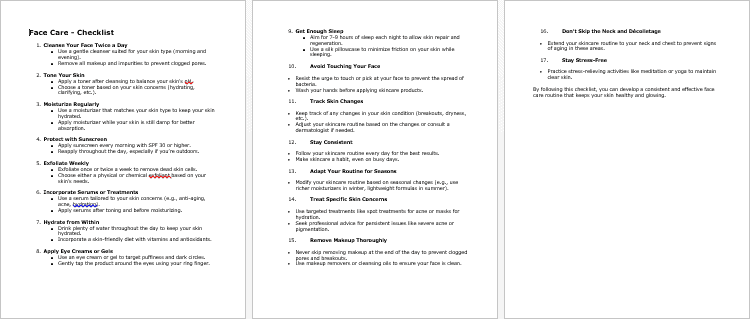
Face Care – FAQs

Face Care – Salespage Content
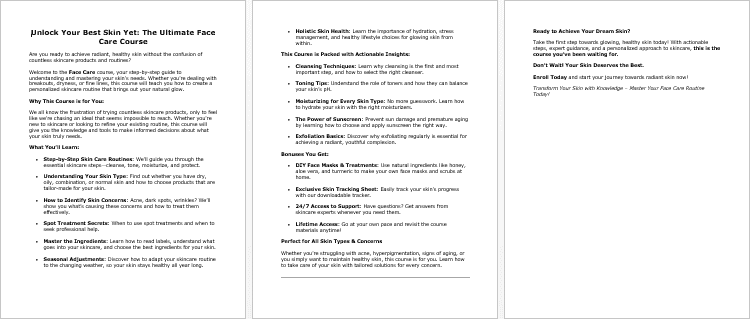
Package Details:
Word Count: 21 976 Words
Number of Pages: 88
Face Care – Bonus Content
Checklist
Word Count: 476 words
FAQs
Word Count: 1053 words
Salespage Content
Word Count: 541 words
Total Word Count: 24 046 Words
Your PLR License Terms
PERMISSIONS: What Can You Do With These Materials?
Sell the content basically as it is (with some minor tweaks to make it “yours”).
If you are going to claim copyright to anything created with this content, then you must substantially change at 75% of the content to distinguish yourself from other licensees.
Break up the content into small portions to sell as individual reports for $10-$20 each.
Bundle the content with other existing content to create larger products for $47-$97 each.
Setup your own membership site with the content and generate monthly residual payments!
Take the content and convert it into a multiple-week “eclass” that you charge $297-$497 to access!
Use the content to create a “physical” product that you sell for premium prices!
Convert it to audios, videos, membership site content and more.
Excerpt and / or edit portions of the content to give away for free as blog posts, reports, etc. to use as lead magnets, incentives and more!
Create your own original product from it, set it up at a site and “flip” the site for megabucks!
RESTRICTIONS: What Can’t You Do With These Materials?
To protect the value of these products, you may not pass on the rights to your customers. This means that your customers may not have PLR rights or reprint / resell rights passed on to them.
You may not pass on any kind of licensing (PLR, reprint / resell, etc.) to ANY offer created from ANY PORTION OF this content that would allow additional people to sell or give away any portion of the content contained in this package.
You may not offer 100% commission to affiliates selling your version / copy of this product. The maximum affiliate commission you may pay out for offers created that include parts of this content is 75%.
You are not permitted to give the complete materials away in their current state for free – they must be sold. They must be excerpted and / or edited to be given away, unless otherwise noted. Example: You ARE permitted to excerpt portions of content for blog posts, lead magnets, etc.
You may not add this content to any part of an existing customer order that would not require them to make an additional purchase. (IE You cannot add it to a package, membership site, etc. that customers have ALREADY paid for.)
Share Now!


